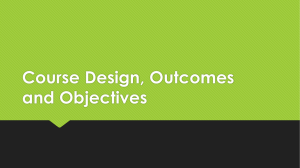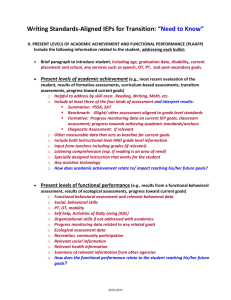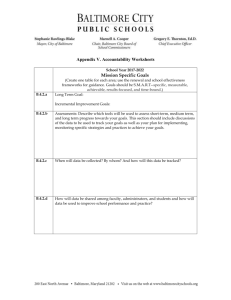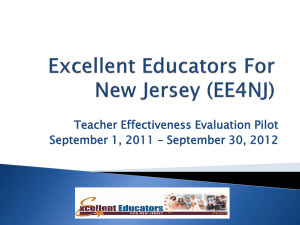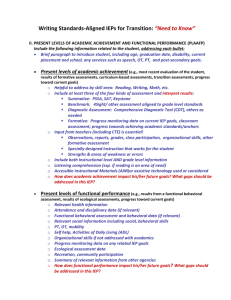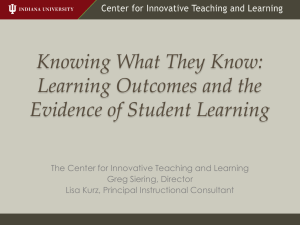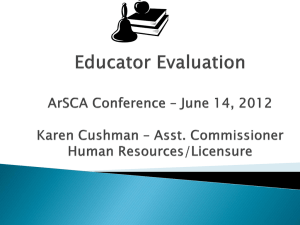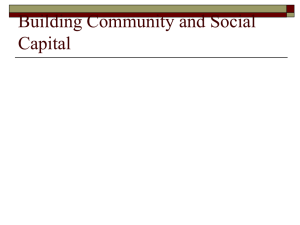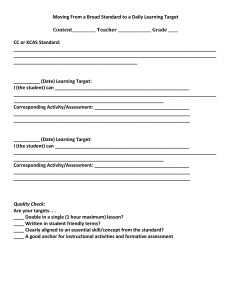tpges
advertisement
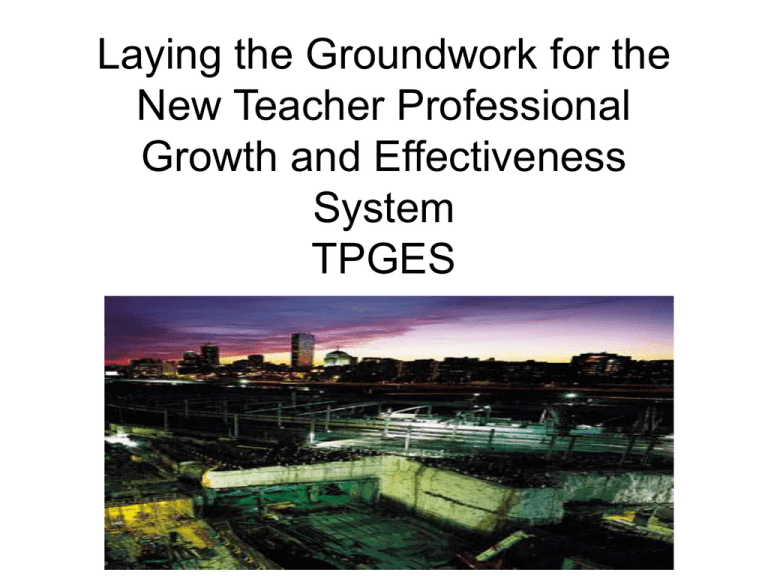
Laying the Groundwork for the New Teacher Professional Growth and Effectiveness System TPGES TPGES Timeline Spring Pilot of selected measures: Summer training for pilot districts 4 days Online Observation Calibration Student Growth Professional Growth 2013/14 – All districts will pilot the process 2012/13 – 55+ districts will pilot the entire process with teachers 2014 – The Teacher Effectiveness Framework will be put into place across the state CHANGES • Forms have been condensed and made more user friendly. • Parent Voice • Charlotte Danielson Framework for Teaching Will……. Won’t……. • Introduce you to all of the documents or spend a long time on the specific process as it is now. • Give you an idea of the types of changes that will be necessary for your district/school. • Help you analyze what is currently in place in your district/school that will support the new system. • Identify some refinements to your current processes that would better prepare your staff. What can be done now within your current operations? Share ideas that you have with your table and ultimately with the group. Think about your context! Identify what a natural next step would be for your staff. At the end of the session be ready to identify at least one change that you can make that will better prepare both you and your teachers for the changes. Learning Targets I Can….. Analyze what I am currently doing that aligns with processes/expectations of the Teacher Professional Growth and Effectiveness System. Identify one or more refinement(s) that I can make this year that would better prepare my staff for implementing the Teacher Professional Growth and Effectiveness System. Does your district/school have a culture of continuous improvement for students, teachers and administrators? Are my evaluation comments evidence based vs. opinion based? Do I know how to use evidence to have collaborative conversations with my teachers about instruction? Does everyone in my school know how to write effective and measurable goals? Do the administrators know how to identify strong goals and provide feedback when needed? Do I expect all teachers, not just ELA and Math, to have an assessment system in place that will allow them to show student growth and progress? DOES YOUR SCHOOL/DISTRICT HAVE A CULTURE OF Growth expected throughout the process Teachers will be asked to set goals, collect data and reflect on the improvement for both: Professional Growth Student Growth Reflection! Reflection! Reflection! What is a Culture of Continuous Improvement? • A ‘continuous improvement culture’ is a shared value system that promotes the belief that what is good enough today is not good enough for tomorrow. • Kaizen – Toyota’s improvement process – continual focus on improvement of all standard activities and processes by all of the employees – from the CEO down. • A place where all members of the staff are learning, growing, and working to increase student achievement Transforming Schools: Creating a Culture of Continuous Improvement. Continuous Improvement involves: Identify core beliefs; Create a shared vision; Use data to determine gaps between the current reality and the shared vision; Identify the innovations that will most likely close the gaps; Develop and implement an action plan; Endorse collective accountability. Transforming Schools: Creating a Culture of Continuous Improvement. = = WHAT ABOUT YOU? Your reactions – Who solves the problems in your school? – How do you respond to staff – do you encourage their problem solving? Your structures – Committees, team meetings, etc. – Staff meeting Your processes – Who is involved? – Do your teachers have know how to solve problems or do they want you to “tell them what to do” Involving Problem Solving Staff in Using technology Moodle sites Discussion boards Wikkis Committee structures – Clearly outlined goals Provide the resources Developing teacher leadership How does the principal interact with the staff? Is first response always to solve the problem? What questions do you ask to encourage teachers to problem solve independently? What do you currently have in place that encourages a culture of problem solving? Put your ideas on the post its at your table. Someone will be around to collect them in 5 minutes. Effective Evaluation Feedback Evidence Based Feedback? Evidence Based Identifying what the teacher SAYS and DOES during a lesson and using that information in evaluation. Current Evaluation Practices: Are my evaluation comments evidence based vs. opinion based? Do I know how to use evidence to have collaborative conversations with my teachers about instruction? • System includes multiple measures: – – – – – – Professional Growth Self Reflection Student Growth Student Voice Principal Observation Peer Observation • In Principal and Peer observation a focus is on evidence: – What did the teacher do or say that provides evidence for a particular component in the framework. Observe, Record, Interpret DATA EVIDENCE FOR A COMPONENT INTERPRETATION JUDGMENT Evidence Vs. Opinion Evidence FACTS ARTIFACT S OBSERVATIONS Now you try it • Identify which statements would be identified as evidence and which would be opinion. • If the statement is opinion – rewrite it to make it an evidence statement. Uses of Evidence Observation Feedback Conference discussions Documentation of Teacher Rating De-Personalizes the discussion Focuses on the work Shifts conferencing to a Collaborative Analysis of the instruction or student work Provides unbiased documentation of a teacher’s work • Go back and pull out 3 evaluations from last year: – Strong teacher – Average teacher – Weak teacher • Look at your comments: – Were they evidence based or opinion based? – Was there a difference in how you wrote your comments based on your perception of the teacher? What do you currently have in place that involves the use of evidence in the evaluation? process? Put your ideas on the post its at your table. Someone will be around to collect them in 5 minutes. • Student Growth Component – Only 30% of the teachers will have Growth data from the ELA/Math State Assessment – All other teachers will be using either district, school or classroom assessments to show student growth • Program Review Connections – In all of the Program Reviews there is an expectation of being able to document student growth and assessment processes. CONSIDER! Know that decisions about the use of assessment in the Student Growth Component are still in process – Feedback from the pilot districts will be instrumental. Think about best practices for assessment – both formative and summative. Remember that we have not always had the same expectations for teachers across the curriculum about assessment expectations. Program Reviews are holding districts/schools to a higher level of accountability for all classrooms. Don’t Forget CASL Formative & Summative Assessment Processes Provides a way to build consistency between all classrooms in the way they go about using formative and summative assessment Types of Assessments DISTRICT STATE CLASSROO M SCHOOL ANALYZE: • What assessments and assessment structures do you currently have in place? • What is missing? What structures do you currently have in place to ensure that all classrooms have effective assessments in place that could be used to measure student growth? Put your ideas on the post its at your table. Someone will be around to collect them in 5 minutes. • Teachers are going to be asked to set goals for: – Professional Growth – Student Growth • Effective goals are: – Specific, Measurable, Attainable, Realistic & Timely Strong Goals = Greater Opportunities for Success CDIP/CSIPs Professional Learning Communities RTI Who has been involved in writing these goals in your school/district? Taking a Closer Look at Goals CDIP Goals…….. • Increase the percentage of Exemplary School District’s students scoring proficient or advanced in reading from 85% to 90% from 2012 to 2013 as measured by KPREP. A good goal statement is one that is… Specific Measurable Appropriate Realistic Time-bound PLC GOALS • This year, 86% of our economically disadvantaged students will score proficient/advanced on the Algebra I Gateway assessment. A good goal statement is one that is… Specific Measurable Appropriate Realistic Time-bound INDIVIDUAL TEACHER GOALS…… • Goal Statement: • For the 2011 – 12 school year, 100% of students will make measurable progress in writing. Each student will improve by one performance level in two or more areas of the rubric (audience/purpose, idea development, organization & structure). Furthermore, 80% of the students will score a “3” or better overall. A good goal statement is one that is… Specific – Measurable – AppropriateRealistic - Time-bound Analyze your Current Situation Do your teachers know how to write strong goals? Do your administrators know how to evaluate and provide feedback to improve goals? What do you currently have in place that involves the use of goals and providing feedback on goals that is working for you? Put your ideas on the post its at your table. Someone will be around to collect them in 5 minutes. NEXT STEPS
